2. 北京离子探针中心, 北京 100037
2. Beijing SHRIMP Center, Beijing 100037, China
早前寒武纪地质演化及其克拉通化过程一直是华北克拉通研究的重要内容之一。前人长期研究认为, 华北是由多个微陆块组成(伍家善等, 1998;Zhai et al., 2000, 2005;Zhai and Santosh, 2011)。这些微陆块在新太古代末期通过陆-陆或弧-陆碰撞拼合在一起, 初步形成华北克拉通的基本轮廓(伍家善等, 1998;Shen and Qian, 1995;Zhai et al., 2000, 2005;Zhai and Santosh, 2011;Zhai, 2011)。近十多年来, 新的研究提出将华北克拉通分为东部陆块、西部陆块和中部造山带, 并通过东、西两个陆块的拼合完成华北克拉通化过程(Zhao et al., 1999a, b, 2005;Kusky and Li, 2003;Li and Kusky, 2007)。但对于东、西陆块之间的俯冲方向和陆块的拼合时代有两种不同认识:一种观点认为, 从新太古代末期开始, 西部陆块向东部陆块连续俯冲, 古元古代末期(1.85~1.8Ga) 东西陆块拼合(Zhao et al., 1999a, b, 2000, 2005, 2008, 2010;Kröner et al., 2005a, b;Wilde et al., 2005;Liu et al., 2004, 2006, 2012;Wan et al., 2006a, b;Zhang et al., 2007, 2009);而另一种观点提出, 新太古代晚期东部陆块向西部陆块俯冲, 在新太古代末期东西陆块拼合, 并在古元古代早期华北克拉通转入陆内伸展阶段(Kusky and Li, 2003;Kusky et al., 2007;Li and Kusky, 2007;Polat et al., 2005)。此外, 有些学者根据中部带内基底岩石构造变形和2.2~2.1Ga岩浆岩地球化学特征, 提出中部带内存在~2.1Ga和1.9~1.8Ga两阶段俯冲/碰撞模式(Liu et al., 2005;Faure et al., 2007;Trap et al., 2008, 2009;Wang, 2009;Wang et al., 2010)。目前, 关于中部带内太古代-古元古代地质演化争议很大, 但研究重点多集中于~2.5Ga和1.85~1.8Ga两期地质事件的性质(Guan et al., 2002;Guo et al., 2002, 2005;Kröner et al., 2005a, b, 2006;Liu et al., 2006;Wan et al., 2006a, b;Wilde et al., 2005;Zhou et al., 2011;杨崇辉等, 2011a), 而对中部带内2.5~1.9Ga的古元古代岩浆事件性质研究程度相对较低。
吕梁地区位于中部带内, 区域内不仅保留有大量的古元古界地层, 而且古元古代不同阶段的岩浆岩出露较为广泛。通过这些古元古代岩浆(火山) 岩的综合研究, 对探讨吕梁地区早期演化历史、客观恢复华北克拉通过程具有重要意义。本文对区域内2.2~2.1Ga的基性火山岩和酸性火山/侵入岩进行系统研究, 结合区域岩石组合、地球化学和年代学资料, 对吕梁地区该期岩浆事件性质及意义进行了探讨。
2 地质背景吕梁地区位于华北克拉通中部。在Zhao et al.(1999a, b, 2005) 的华北克拉通划分方案中, 吕梁地区位于中部造山带中段西侧, 其东邻五台地区, 西与鄂尔多斯地块断层相隔(图 1)。区域内出露的早前寒武纪地层主要有界河口群、吕梁群、野鸡山群、岚河群和黑茶山群, 还分布有大量的古元古代花岗岩(图 2)。

|
图 1 华北克拉通构造简图(Zhao et al., 2005) Fig. 1 Three-fold tectonic subdivision of the North China Craton (after Zhao et al., 2005) |

|
图 2 吕梁地区地质简图(据耿元生等, 2000;刘树文等, 2009修改) Fig. 2 Geological sketch map of Lüliang Mountains (modified after Geng et al., 2000; Liu et al., 2009) |
界河口群主要呈NNE向分布于吕梁地区的兴县交楼申、奥家滩、东会至汉高山一带。此外, 在文水县西榆皮-东社、交城县米家庄等地也有少量出露(Liu et al., 2003)(图 2)。界河口群以碎屑岩-碳酸盐岩为主, 夹少量的基性火山岩, 总体经历了角闪岩相变质, 其岩石组合与变质作用特征类似于典型的孔兹岩系, 形成于被动大陆边缘构造环境(万渝生等, 2000)。由于界河口群以变质沉积岩为主, 其形成时代一直难以准确限定。Liu et al.(2003)根据界河口群变质基性火山岩中获得2635Ma的Nd模式年龄和2464±130Ma的Sm-Nd等时线年龄, 提出前者代表了岩浆喷发时代, 而后者为变质作用年龄, 与华北其他地区广泛发育新太古代末期变质作用相似。而万渝生等(2000)通过界河口群变质碎屑沉积岩Nd模式年龄和锆石U-Pb年龄综合分析, 限定其沉积时代可能为古元古代中-晚期。
野鸡山群总体呈南窄北宽的狭长带状分布, 在野鸡山一带出露最宽, 其东、西分别与赤坚岭花岗质杂岩和界河口群呈断层接触(图 2)。野鸡山群主体以陆源碎屑岩为主, 底部层位有砾岩出现, 中上部发育厚层基性火山岩, 夹流纹岩和薄层碳酸盐岩, 总体为绿片岩相变质。耿元生等(2000)从野鸡山群白龙山组长英质凝灰岩中获得单颗粒锆石U-Pb年龄为2124±38Ma, 限定野鸡山群形成于古元古代。Liu et al.(2011)在野鸡山群底部变质砂岩中获得最年轻一组碎屑锆石年龄为2122Ma, 但根据顶部层位砂岩中碎屑锆石年龄1833±26Ma, 限定野鸡山群沉积时代为1840Ma之后。最近, Liu et al.(2012)从野鸡山群变质基性次火山岩中获得锆石U-Pb年龄2214±56Ma, 限定野鸡山群时代可能为2.2~2.0Ga。
吕梁群位于研究区的中部, 南部被片麻状花岗岩侵入而未见底(耿元生等, 2008)(图 2)。吕梁群中、下部层位以碎屑沉积岩为主, 底部含有条带状铁建造(BIF), 中上部分布大量的基性火山岩, 顶部以酸性火山岩为主, 总体经历了绿片岩相-低角闪岩相变质。耿元生等(2000)在吕梁群近周峪组变质酸性火山岩中获得单颗粒锆石U-Pb年龄2360±95Ma, 同时获得变质基性火山岩Sm-Nd等时线年龄2351±56Ma, 从而限定近周峪组火山岩的时代为2350~2360Ma。吕梁群上部杜家沟组的年龄为2099±41Ma (于津海等, 1997) 和2174±9Ma (耿元生等, 2008)。而Liu et al.(2012)在吕梁群近周峪组获得变质基性次火山岩的锆石U-Pb年龄为2213±47Ma, 认为吕梁群形成时代也为2.2~2.0Ga, 与野鸡山群相当。
岚河群分布于岚县南北两处(图 2), 不整合于吕梁群之上, 岩石组合以碎屑沉积岩为主, 经历了低绿片岩相变质。黑茶山群仅出露于兴县会东乡北黑茶山东坡(图 2), 不整合于界河口群之上, 主要岩石组合也是一套陆源碎屑岩, 经历了低绿片岩相变质。现有的资料认为岚河群和黑茶山群属古元古界地层, 但具体沉积时代还不明确。
吕梁地区的花岗岩主要分布于研究区的东南部, 北部地区也有一定规模出露(图 2)。就其侵位时代而言, 最早形成的是盖家庄片麻状二长花岗岩, 年龄为2364~2375Ma (耿元生等, 2006;Zhao et al., 2008)。其次, 分布范围较广泛的是赤坚岭-关帝山花岗质片麻岩, 时代为2.2~2.0Ga (耿元生等, 2000;Zhao et al., 2008)。另外, 区域内还存在古元古代晚/末期(1.9~1.8Ga) 花岗质岩浆活动记录(耿元生等, 2006;Zhao et al., 2008)。
3 野外地质与岩石学特征吕梁群自下而上划分为袁家村组、裴家庄组、近周峪组和杜家沟组(耿元生等, 2000)。袁家村组和裴家庄组以碎屑沉积岩为主, 在袁家村组中赋存有条带状铁建造(BIF)。而中上部的近周峪组主体岩性以玄武岩为主, 杜家沟组以流纹岩为主。
杜家沟组主要分布于方山县马坊、杜家沟和水峪一带, 岩性以变质流纹岩为主(于津海等, 1998)。刘树文等(2009)指出, 杜家沟组流纹岩实为糜棱岩化的花岗岩, 保留有“σ”和“δ”型长石的眼球状斑晶。本文对方山县高明村和杜家沟一带出露的原杜家沟组火山岩进行野外调查。杜家沟变质酸性火山岩呈浅灰紫色, 总体强烈糜棱岩化(图 3a), 其中残留有长石斑晶, 局部保留有流动构造, 而变形较弱时显示花岗岩特征。野外初步判断, 原划为杜家沟组的变质流纹岩原岩可能为浅成的酸性侵入体, 本文暂称为杜家沟长石斑岩。显微镜下, 岩石具糜棱结构, 碎斑含量10%~15%, 主要为斜长石、钾长石和磁铁矿(图 4a), 也有少量石英, 基质主要为微晶的石英和长石和少量的绢云母, 绢云母定向排列较明显(图 4a)。

|
图 3 吕梁地区2.2~2.1Ga岩浆岩的野外照片 (a)-强烈糜棱岩化的杜家沟长石斑岩;(b)-吕梁群近周峪组变质基性火山岩中杏仁体, 部分变形拉长;(c)-近周峪组变质基性火山岩中暗色矿物集合体;(d)-恶虎滩闪长质片麻岩中片麻状构造;(e)-闪长质片麻岩发生强烈深熔;(f)-深熔的花岗闪长质片麻岩被后期花岗质伟晶岩脉穿插 Fig. 3 Outcrop pictures of 2.2~2.1Ga magmatic rocks in Lülinag Mountains (a)-strong mylonitized Dujiagou feldspar porphyrite; (b)-partially deformed amygdaloid bodys in metamorphosed basalt of Jinzhouyu Formation, Lüliang Group; (c)-dark minerals aggregates in metamorphosed basalt of Jinzhouyu Formation, Lüliang Group; (d)-gneissic structure in Ehutan dioritic gneiss; (e)-strong anatexis of Ehutan dioritic gneiss; (f)-granitic pegmatite vein penetrates the granitic gneiss |
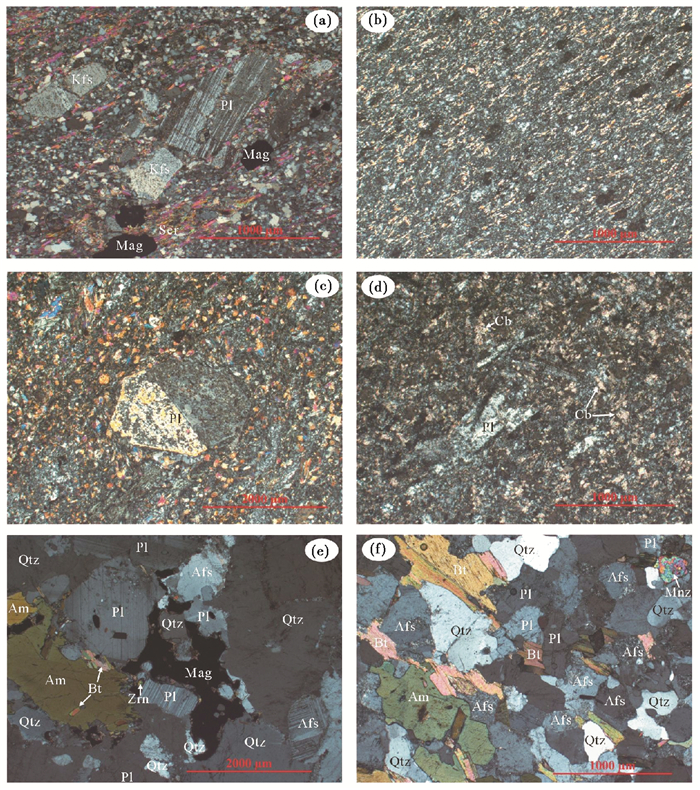
|
图 4 吕梁地区2.2~2.1Ga岩浆岩显微照片 (a)-糜棱岩化长石斑岩中保留的斜长石、钾长石和磁铁矿碎斑;(b)-近周峪组变质基性火山岩中变余交织结构;(c)-变质基性火山岩中斜长石斑晶的巴温诺双晶;(d)-强烈碳酸盐化的变质基性火山岩;(e)-恶虎滩闪长质片麻岩矿物组成和结构;(f)-恶虎滩花岗闪长质片麻岩矿物组成和结构.矿物缩写代号据沈其韩(2009) Fig. 4 Microscopic photos of 2.2~2.1Ga magmatic rocks in Lüliang Mountains (a)-plagioclase, K-feldspar and magnetite porphyroclasts in mylonitized feldspar porphyrite; (b)-interlocking texture in basalt of Jinzhouyu Formation; (c)-Baveno twin of plagioclase phenocryst in metamorphosed basalt; (d)-strong carbonation of metamorphosed basalt; (e)-mineral compositions and microscopic structure of dioritic gneiss; (f)-mineral compositions and microscopic structure of granitic gneiss. Mineral abbreviations after Shen (2009) |
近周峪组为吕梁群中最主要的基性火山岩层, 底部为一套变质砾岩、含砾变质砂岩和变质粉砂岩组合(耿元生等, 2008)。变质中基性火山岩呈灰绿色, 片状构造, 片理产状50°∠50°, 其中保留有气孔构造、杏仁构造, 杏仁体成分主要为石英, 由于构造变形部分杏仁体被变形拉长(图 3b), 可见火山岩中存在许多暗色矿物集合体(图 3c)。显微镜下, 岩石具有变余斑状结构和变余交织结构(图 4b, c), 斑晶主要为斜长石, 其中可见斜长石巴温诺双晶(图 4c), 基质主要为微晶板条状斜长石和辉石, 绢云母化和绿帘石化强烈, 部分样品中(例如LL17-1) 可见较强烈的碳酸盐化(图 4d)。变质程度较高的样品(如LL26-1和LL26-4) 为变晶粒状-柱状结构, 主要组成矿物为细粒角闪石、斜长石和石英。
恶虎滩片麻岩主要分布于岢岚县和兴县交楼申之间, 在忻州芦芽山以南也有出露(张兆琪等, 2004)。恶虎滩片麻岩以闪长质-花岗闪长质岩石为主, 中-细粒结构, 片麻状构造(图 3d), 暗色矿物以角闪石为主。局部发生强烈的深熔作用(图 3e), 可见后期的花岗质伟晶岩贯入(图 3f)。闪长质片麻岩为中-细粒状变晶结构, 主要组成矿物为斜长石(30%~35%)、碱性长石(20%~25%)、石英(10%~15%)、黑云母(5%~7%)、角闪石(5%~10%), 磁铁矿少量(2%~5%), 副矿物主要为锆石。斜长石呈半自形板状-他形粒状, 多发育密集的聚片双晶;碱性长石呈他形粒状, 格子状双晶发育;石英为他形粒状, 部分充填于长石颗粒之间;角闪石呈半自形, 单偏光下多具有黄绿-蓝绿多色性;黑云母呈片状, 多分布于长石颗粒之间, 具定向-半定向排列;磁铁矿呈他形充填于长石和石英粒间(图 4e)。花岗闪长质片麻岩具中-细粒状变晶结构, 主要组成矿物为碱性长石(~30%)、斜长石(20%~30%)、石英(20%~25%)、角闪石(5%~7%), 黑云母(5%~10%), 副矿物为独居石和锆石。碱性长石多成他形粒状, 部分高岭土化;斜长石呈半自形板状-他形粒状;石英呈他形粒状, 部分充填于长石与角闪石或黑云母矿物颗粒间;角闪石呈半自形柱状-他形;黑云母呈半自形片状-他形, 多分布于长石和石英颗粒之间(图 4f)。
4 分析方法全岩粉末样品的制备由河北省区域地质矿产调查研究所完成。选取300~500g新鲜的岩石样品利用鄂式破碎机破碎后, 用粉碎机将样品碎块粉碎研磨至200目以下, 取其中30~50g以备全岩化学分析。全岩主量、稀土和微量元素分析在中国地质科学院国家地质实验测试中心完成。其中主量元素用日本理学3080E型X荧光光谱仪(XRF) 分析, 误差 < 0.5%;稀土和微量元素用电感耦合等离子体质谱(X-Series) 分析, 分析误差 < 5%。
锆石单矿物分选在河北省区域地质矿产调查研究所完成。SHRIMP锆石U-Pb年龄测试在中国地质科学院地质研究所北京离子探针中心的网络虚拟实验室, 通过SHRIMP远程共享控制系统(SHRIMP Remote Operation System, SROS) 远程控制位于澳大利亚Curtin理工大学的SHRIMP Ⅱ仪器进行的。SHRIMP远程共享控制系统(SROS) 由北京离子探针中心、中国计量科学研究院和吉林大学共同研发, 可以实现通过Internet公共网络, 远程控制SHRIMP Ⅱ仪器, 远程选取样品待测点和实时远程实验数据输出打印等功能。具体实验分析原理和流程见文献(Williams, 1998;宋彪等, 2002)。测试过程中仪器质量分辨率大于5000(1%峰高), 一次离子流O2-强度为6~7nA, 一次离子流束斑大小为20~30μm。应用标准锆石SL13(U含量为238×10-6)(Williams, 1998) 和TEM (TEMORA1年龄为417Ma)(Black et al., 2003) 分别标定未知样品U、Th含量和年龄校正。每分析4个待测样品进行一次TEM标样测定, 每个测点采用5组扫描。数据处理用SQUID1.02(Ludwig, 2001) 和ISOPLOT (Ludwig, 2000) 程序。普通铅用实测的204Pb校正。单个分析数据的误差为1σ。年龄结果采用207Pb/206Pb加权平均值, 内部误差为2σ(95%的置信度)。
5 分析结果 5.1 地球化学 5.1.1 杜家沟长石斑岩4个样品分析, 杜家沟长石斑岩高SiO2(71.36%~75.31%)、K2O (6.32%~8.84%)、FeOT (Fe2O3+FeO) 和FeOT/MgO, 低Al2O3(12.02%~13.26%)、CaO (0.28%~0.78%)、Na2O (1.46%~2.4%)、MgO (0.08%~1.06%) 和TiO2(0.24%~0.35%)(表 1)。在TAS (SiO2-K2O+Na2O) 分类图中, 所有的长石斑岩样品位于碱性花岗岩区域(图 5a), 具有偏铝质至过铝质花岗岩组成特征(图 5b)。
|
|
表 1 吕梁地区2.2~2.1Ga岩浆岩主微量元素分析表(主量元素:wt%;稀土和微量元素:×10-6) Table 1 Major compositions and trace elements of 2.2~2.1Ga magmatic rocks in Lüliang Mountains (Major elements: wt%; Trace elements: ×10-6) |
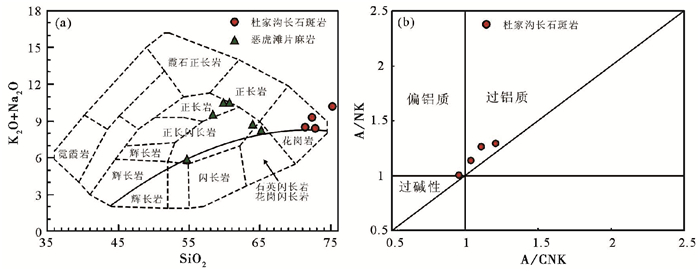
|
图 5 吕梁地区2.2~2.1Ga岩浆岩K2O+Na2O-SiO2 (a, 据Wilson, 1989) 和A/NK-A/CNK (b, 据Maniar and Piccolli, 1989) 关系图 Geochemical diagrams of the 2.2~2.1Ga magmatic rocks in Lüliang Mountains (a)-K2O+Na2O versus SiO2 (after Wilson, 1989); (b)-molar Al2O3/(K2O+Na2O) versus Al2O3/(CaO+ K2O+Na2O) (after Maniar and Piccolli, 1989) |
长石斑岩稀土元素总量高(312.6×10-6~442.4×10-6)(表 1)。在球粒陨石标准化的稀土元素配分图解中(图 6a), 长石斑岩具有较强烈的轻重稀土元素分异((La/Lu)CN=7.34~8.06), 其中轻稀土元素相对分异较明显((La/Sm)CN=3.50~4.10), 而重稀土元素分异较弱((Gd/Lu)CN=1.37~1.51), 具有较强烈的负Eu异常(Eu/Eu*=0.19~0.42)。
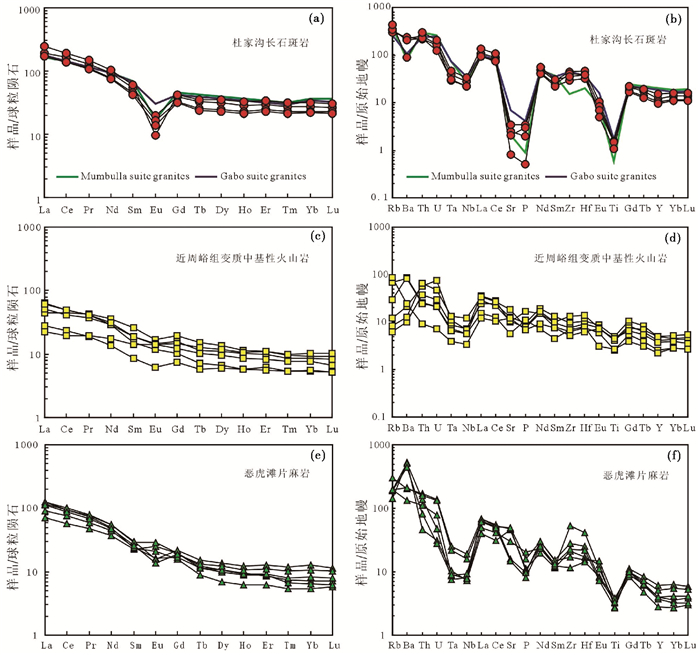
|
图 6 吕梁地区2.2~2.1Ga岩浆岩的稀土和微量元素配分图解(球粒陨石标准化值据Henderson, 1984;原始地幔标准化值据Sun and McDonough, 1989) Fig. 6 Chondrite-normalized REE patterns and primitive mantle-normalized trace elements patterns of the 2.2~2.1Ga magmatic rocks in Lüliang Mountains (normalization values of chondrite and primitive mantle after Henderson, 1984; Sun and McDonough, 1989, respectively) |
微量元素中, 长石斑岩富集Zr、Hf、Nb、Ta、Y和Ga, 相对贫Sr、V、Cr、Co和Ni。在原始地幔标准化的微量元素配分图解中(图 6b), 长石斑岩相对富集Rb、Th、U、REEs (Eu除外)、Zr和Hf, 而明显亏损Nb、Ta、Sr、P和Ti, 略亏损Ba, 与典型的Lachlan Fold Belt中A型花岗岩相似(Collins et al., 1982)。
5.1.2 近周峪组变质中基性火山岩6个样品分析, 吕梁群近周峪组变质中基性火山岩的SiO2含量为46.87%~57.33%, TiO2含量为0.56%~1.08%, Al2O3含量为12.26%~17.25%, Fe2O3含量为1.33%~3.14%, FeO含量为4.76%~8.57%, CaO含量为3.31%~10.62%, MgO含量为3.22%~11.39%(Mg#为38~76), K2O含量为0.08%~2%, Na2O含量为2.02%~4.09%(表 1)。近周峪组变质中基性火山岩具有低TiO2特征, 主量元素变化范围较大, 部分样品具有高镁安山岩的组成特征。基性火山岩的烧失量普遍较高, 与其绿片岩相变质作用有关。因此, K和Na这些活动性元素可能已发生迁移, 不能利用TAS图进行岩石分类, 故选择相对稳定的不活动性元素进行岩石分类。在火山岩Nb/Y-Zr/TiO2分类图中, 吕梁群近周峪组变质中基性火山岩样品位于亚碱性玄武岩-安山岩区域(图 7a)。在FeOT/MgO-SiO2图中, 一些样品分布于拉斑玄武岩系列范围, 而一些样品属于钙碱性玄武岩系列(图 7b)。
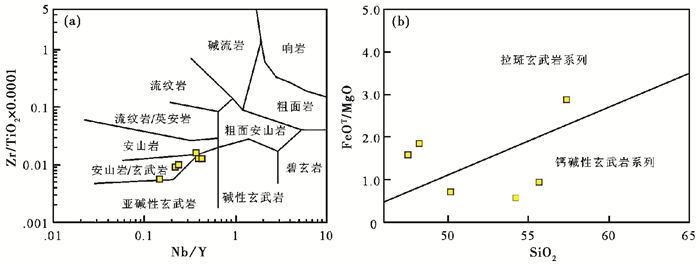
|
图 7 吕梁群近周峪组变质中基性火山岩的岩石分类图(a, 据Winchester and Floyd, 1977;b, 据Miyashiro, 1974) Fig. 7 Zr/TiO2×10000 versus Nb/Y (a, after Winchester and Floyd, 1977) and FeOT/MgO versus SiO2 diagrams (b, after Miyashiro, 1974) of intermediate basic volcanic rocks in Jinzhouyu Formation of Lüliang Group |
吕梁群近周峪组变质中基性火山岩稀土元素总量较低, 且变化范围较大(表 1)。在球粒陨石标准化的稀土元素配分图解中(图 6c), 多数样品具有较强烈的轻重稀土元素分异((La/Lu)CN=3.32~6.14), 而LL10-2样品相对其他样品轻重稀土元素分异更为强烈((La/Lu)CN=12.44), 并具有弱的Eu异常(Eu/Eu*=0.74~1.05)。
在微量元素中, 变质基性火山岩Ni、Cr、V、Co和Sc相对较高, 而Th、U、Nb和Ta含量较低(表 1)。在原始地幔标准化的微量元素配分图解中(图 6d), 所有的样品都具有明显的Nb、Ta和Ti负异常, 而无Zr、Hf负异常。
5.1.3 花岗闪长质-闪长质片麻岩恶虎滩片麻岩中, SiO2含量54.63%~65.15%, TiO2含量0.59%~0.84%, Al2O3含量15.28%~19.19%, Fe2O3含量1.37%~2.53%, FeO含量2.21%~5.37%, CaO含量3.06%~7.44%, MgO含量1.15%~5.17%, K2O含量2.95%~6.68%, Na2O含量3.01%~4.28%(表 1)。恶虎滩片麻岩具有低TiO2、FeOT和MgO, 高Al2O3和K2O特征。在TAS分类图中, 恶虎滩片麻岩主要位于正长-闪长岩区域, 少量在花岗闪长岩(石英闪长岩) 区域(图 5a)。
恶虎滩片麻岩稀土元素总量为140.0×10-6~224.7×10-6(表 1)。在球粒陨石标准化的稀土元素配分图解中(图 6e), 所有样品皆表现为明显右倾的稀土配分模式, 具强烈的轻重稀土元素分异((La/Lu)CN=9.87~22.01) 和弱的正或负Eu异常(Eu/Eu*=0.62~1.18)。
微量元素中, 恶虎滩片麻岩富含Sr和Ba, Ni、Cr、Sc、Co和V含量低(表 1), 具有较高的Sr/Y值(12.15~77.19)。在原始地幔标准化的微量元素配分图解中(图 6f), 所有的样品皆显示强烈的Nb、Ta、Ti和P负异常。
5.2 锆石U-Pb年龄 5.2.1 长石斑岩本次工作共采集了2件长石斑岩样品进行锆石U-Pb同位素定年, 其中LL08-1样品采自方山县马坊镇薛家沟村附近(经纬度:38°03′17.7″N, 111°26′26.6″E), LL09-1样品采自方山县马坊镇高明村西(经纬度:38°03′22.9″N, 111°25′40.6″E)。
长石斑岩(LL08-1和LL09-1) 锆石主要为粒状-短柱状, 个别呈长柱状。透射光下, 锆石无色透明, 粒度大小多为100~150μm, 长宽比为1:1~1:2, 柱面通常较发育, 而锥面不发育。阴极发光图像中, 多发育明显的振荡环带(图 8a-f, h), 部分可见板状环带(图 8g), 具岩浆成因锆石特征。
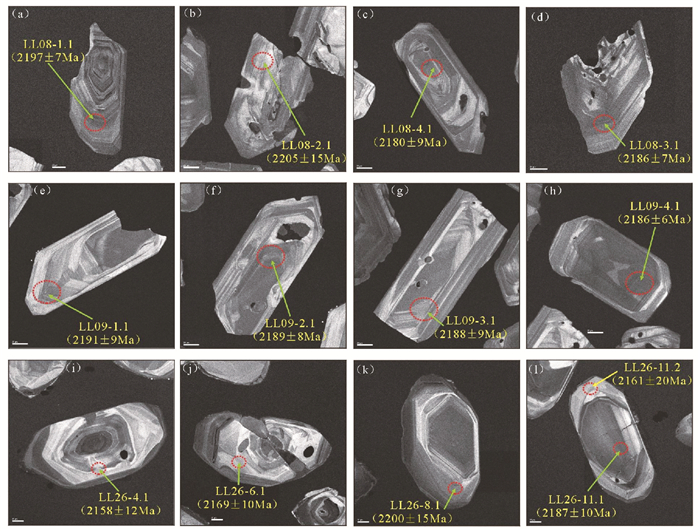
|
图 8 吕梁地区2.2~2.1Ga岩浆岩的锆石CL图像(比例尺为20μm) Fig. 8 CL images of zircons from 2.2~2.1Ga magmatic rocks in Lüliang Mountains (scale is 20μm) |
对于LL08-1样品, 随机选择了8颗锆石进行了8个测点分析, 结果见表 2。U、Th含量分别为129×10-6~363×10-6和50×10-6~241×10-6, Th/U比值为0.45~0.69(表 2)。在锆石U-Pb年龄谐和图中(图 9a), 8个分析点的结果多位于谐和线上或附近, 207Pb/206Pb加权平均年龄为2189±6Ma (MSWD=1.4)。
|
|
表 2 吕梁地区2.2~2.1Ga岩浆岩SHRIMP锆石U-Pb分析 Table 2 SHRIMP U-Pb analyses on zircons from 2.2~2.1Ga magmatic rocks in Lüliang Mountains |
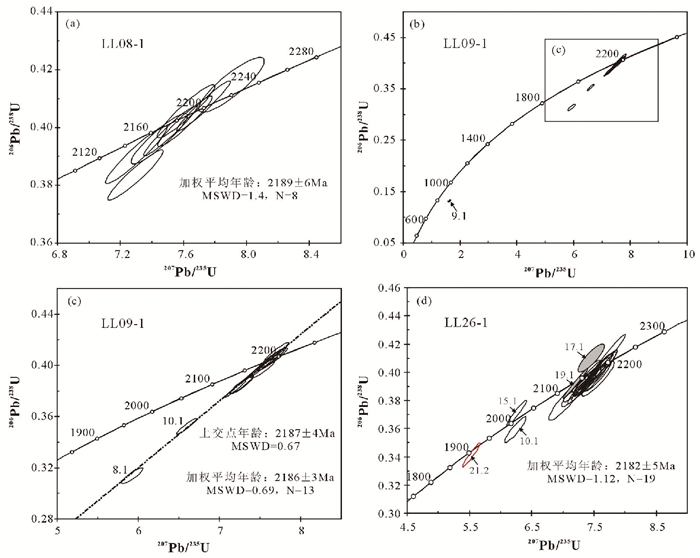
|
图 9 吕梁地区2.2~2.1Ga岩浆岩锆石U-Pb年龄谐和图 Fig. 9 U-Pb concordia of zircon from 2.2~2.1Ga magmatic rocks in Lüliang Mountains |
对于LL09-1样品, 测试过程中随机选择了14颗锆石完成了14个测点分析, 具体结果见表 2。锆石U、Th含量分别为128×10-6~1226×10-6、63×10-6~1565×10-6, Th/U比值为0.48~1.46(表 2)。在锆石U-Pb年龄谐和图中(图 9b), 分析点9.1具有强烈的铅丢失, 其207Pb/206Pb年龄也明显较低, 可能与后期地质事件引起的铅丢失有关(Amelin et al., 2000)。其余13个分析点获得的上交点年龄结果为2187±4Ma (MSWD=0.67)(图 9c)。在13个分析点中, 8.1和10.1点也具有较明显的Pb丢失, 但其207Pb/206Pb年龄与其他的年龄结果相近, 表明其为锆石自然铅丢失引起的, 因而207Pb/206Pb年龄无明显影响(Amelin et al., 2000)。利用13个分析点获得的207Pb/206Pb加权平均年龄为2186±3Ma (MSWD=0.69)(图 9c), 与上交点年龄完全一致, 同时与LL08-1样品结果相近, 代表了长石斑岩的侵位时代。

|
图 10 杜家沟长石斑岩FeOT/MgO-10000Ga/Al (a) 和(K2O+Na2O)/CaO-10000Ga/Al (b) 判别图(据Whalen et al., 1987) Fig. 10 FeOT/MgO versus 10000Ga/Al (a) and (K2O+Na2O)/CaO versus 10000Ga/Al (b) discrimination diagrams of Dujiagou feldspar porphyrite (after Whalen et al., 1987) |
闪长质片麻岩(LL26-1) 采自兴县恶虎滩乡东(经纬度:38°31′41.7″N, 111°20′.05.6″E)。其中锆石主要为短柱状-长柱状。透射光下, 锆石无色透明, 粒度大小多为100~200μm, 长宽比为1:1.5~1:3, 多数柱面较发育, 而锥面不发育, 部分锆石表面具溶蚀特征。阴极发光图像中, 锆石多具有宽缓的韵律环带(图 8i-l), 少数可见较窄的暗色增生边(图 8i, j), 偶见核部锆石出现流体交代现象(图 8j)。
选择了闪长质片麻岩中22颗锆石进行了24个测点分析(表 2)。U、Th含量分别为44×10-6~207×10-6和7×10-6~131×10-6, Th/U比值为0.04~1.15(表 2)。在锆石U-Pb年龄谐和图中(图 9d), 所有的分析结果都位于谐和线上或附近, 且主要的年龄集中于2.1~2.2Ga之间, 而10.1、15.1和21.2点年龄结果明显偏低。在主体2.1~2.2Ga的分析结果中, 17.1和19.1点年龄稍微偏低, 去除以上2个点后, 其余19个分析点获得207Pb/206Pb加权平均年龄结果为2182±5Ma (MSWD=1.12), 应代表闪长质片麻岩原岩锆石结晶年龄(图 9d)。结合锆石内部结构和锆石Th/U比值, 10.1和15.1点环带结构不明显, 且Th/U比值较高, 可能代表混合年龄;而21.2点位于锆石增生边部, 无明显结构特征, 且具有非常低的Th/U比值(0.04), 具有变质锆石特征。其207Pb/206Pb年龄结果为1919±8Ma, 应代表了后期变质/深熔作用的时代。
6 讨论 6.1 长石斑岩成因及环境于津海等(1997)利用单颗粒锆石U-Pb法获得吕梁群杜家沟组的时代为~2100Ma, 耿元生等(2008)获得该套酸性火山岩的SHRIMP锆石U-Pb年龄为2175±9Ma。本次工作从原吕梁群杜家沟组中获得2件长石斑岩的锆石U-Pb年龄结果分别为2186Ma和2189Ma, 与耿元生等(2008)年龄结果相近, 代表了长石斑岩的侵位时代。
杜家沟长石斑岩高SiO2、Na2O+K2O, 低Al2O3、CaO, 富含REEs (Eu除外)、Zr、Nb、Ga、Y等高场强元素, 而Sr含量低, 具有典型A型花岗岩特征(Collins et al., 1982;Whalen et al., 1987;Patiño Eby, 1990;Douce, 1997)。同时, 所有的长石斑岩样品都具有高Ga/Al比值(3.1~3.53), 也与典型的A型花岗岩相似(Whalen et al., 1987)(图 10)。但已有研究表明, 一些高分异的I或S型花岗岩也具有A型花岗岩的地球化学特征(Whalen et al., 1987;Jiang et al., 2009)。高分异的花岗岩通常具有高Rb、低Sr特征, 同时高场强元素(Zr、Nb和Y等) 含量随着岩浆中锆石等副矿物分离结晶而显著降低。因此, 高Zr+Nb+Y+Ce总量是区分A型花岗岩与高分异型花岗岩的又一重要标志。杜家沟长石斑岩都具有较高Zr+Nb+Y+Ce总量(525.7×10-6~728.3×10-6), 与典型的A型花岗岩相同, 而非高分异的I型或S型花岗岩(图 11)。此外, 利用全岩分析结果计算岩浆Zr饱和温度(Watson and Harrison, 1983;Miller et al., 2003), 所有的长石斑岩都具有很高的Zr饱和温度(868~894℃), 同时, 所有的岩浆锆石中也未出现残留或继承性锆石, 表明岩浆形成温度很高, 也与A型花岗岩的高温特征相似。以上所有证据皆表明, 杜家沟长石斑岩为A型花岗岩。

|
图 11 杜家沟长石斑岩FeOT/MgO (a) 和(K2O+Na2O)/CaO-(Zr+Nb+Y+Ce) (b) 判别图(据Whalen et al., 1987) FG-分异的花岗岩;OGT-未分异的M-, I-和S-型花岗岩 Fig. 11 FeOT/MgO versus (Zr+Nb+Y+Ce) (a) and (K2O+Na2O)/CaO versus (Zr+Nb+Y+Ce) (b) discrimination diagrams of Dujiagou feldspar porphyrite (after Whalen et al., 1987) |
A型花岗岩可能来自于幔源(Loiselle and Wones, 1979;Turner et al., 1992;Litvinovsky et al., 2002;Mushkin et al., 2003)、壳源(Collins et al., 1982;White and Chappell, 1983;Clemens et al., 1986;Whalen et al., 1987;King et al., 1997;Anderson, 1983;Creaser et al., 1991;Skjerlie and Johnson, 1993;Patiño Douce, 1997) 等不同的物质源区和也可形成于壳幔混合作用(Bédard, 1990, Kerr and Fryer, 1993;Mingram et al., 2000;Yang et al., 2006)。于津海等(1998)曾对杜家沟组浅变质火山岩(长石斑岩?) 进行Sm-Nd同位素分析, 本文将其中的(143Nd/144Nd)i根据本文年龄(2190Ma) 进行重新计算, 其εNd(t) 为2.04~2.29, 对应的单阶段(tDM) 和两阶段(t2DM) 亏损地幔模式年龄分别为2291~2310Ma和2431~2452Ma。同时, 长石斑岩都具有高SiO2, 低MgO (Mg#为7~38) 特征, 其难以从地幔部分熔融形成。另外, 长石斑岩样品低Sr (17.1×10-6~71.4×10-6), 具有较明显负Eu异常, 而Yb相对较高(5.44×10-6~8.01×10-6), 类似于张旗等(2006)划分的极低Sr高Yb型花岗岩, 应是浅部地壳发生部分熔融形成的(Anderson, 1983;Creaser et al., 1991;Patiño Douce, 1997)。综合分析认为, 杜家沟长石斑岩很可能是2.5~2.3Ga的浅部地壳岩石部分熔融形成的。
A型花岗岩通常是伸展的构造背景下侵位的, 但其可以出现于板内裂谷环境, 也可以形成于造山后环境(Eby, 1990, 1992;Hong et al., 1996)。在Pearce et al.(1984)的花岗岩构造环境判别图中, 杜家沟长石斑岩皆位于板内构造环境(图 12)。在进一步划分A型花岗岩构造环境相关图解中(Eby, 1992), 杜家沟长石斑岩皆位于A2型区域, (图 13), 即造山后伸展环境。
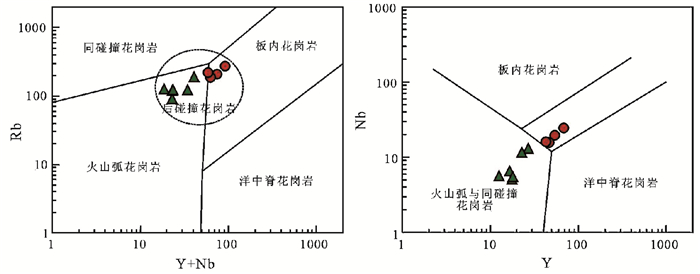
|
图 12 吕梁地区2.2~2.1Ga岩浆岩Rb-(Y+Nb) (a) 和Nb-Y (b) 构造环境判别图(据Pearce et al., 1984) Fig. 12 Rb versus (Y+Nb) (a) and Nb versus Y (b) tectonic discrimination diagrams of 2.2~2.1Ga magmatic rocks in Lüliang Mountains (after Pearce et al., 1984) |
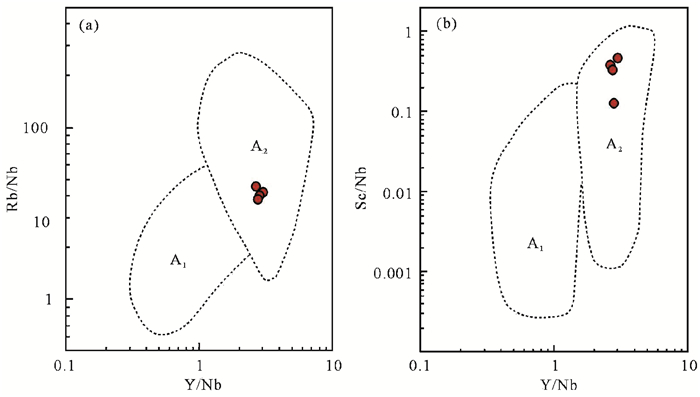
|
图 13 杜家沟长石斑岩Rb/Nb-Y/Nb (a) 和Sc/Nb-Y/Nb (b) 判别图(据Eby, 1992) Fig. 13 Rb/Nb versus Y/Nb (a) and Sc/Nb versus Y/Nb (b) tectonic discrimination diagrams of Dujiagou feldspar porphyrite (after Eby, 1992) |
张其春等(1988)在吕梁群近周峪组变质基性火山岩中获得全岩Sm-Nd等时线年龄2469±150Ma, 从而认为吕梁群时代为新太古代。耿元生等(2000)获得近周峪组变质基性火山岩的全岩Sm-Nd等时线年龄2351±56Ma, 同时获得其中薄层变质酸性火山岩单颗粒锆石U-Pb年龄为2360±95Ma, 限定近周峪组火山岩的时代为2350~2360Ma。于津海等(1997)在近周峪组变质基性火山岩中获得单颗粒锆石U-Pb年龄2051±68Ma, 与吕梁群杜家沟组年龄相近。Liu et al.(2012)在吕梁群近周峪组获得变质基性次火山岩La-ICPMS锆石U-Pb年龄为2213±47Ma, 进一步限定吕梁群时代为2.2~2.0Ga。
耿元生等(2000)对吕梁群近周峪组变质基性火山岩进行了Sm-Nd同位素研究, εNd(t) 平均为-0.35±0.5, tDM值为2665~2884Ma。本文利用Liu et al.(2012)年龄结果对该Sm-Nd同位素重新进行计算后, 其εNd(t) 为-0.91~-2.04, tDM值为2520~2659Ma。从同位素结果分析, 吕梁群近周峪组火山岩可能为富集地幔部分熔融, 也可能是亏损地幔部分熔融并受到地壳强烈混染。近周峪组变质中基性火山岩低TiO2、具有强烈的Nb、Ta和Ti负异常(图 6d), 所以其不是富集地幔部分熔融形成的, 而很可能来自于亏损的地幔源区并受到地壳混染。一些不活动性元素的比值, 如:Nb/Ta、Nb/U、Th/Nb和Zr/Nb多介于N-MORB和上地壳值之间, 进一步表明近周峪组基性火山岩可能源自亏损地幔, 并受到地壳物质的混染。在玄武岩的构造环境判别图中, 近周峪组变质基性火山岩主要位于岛弧拉斑玄武岩和岛弧钙碱性玄武岩区域(图 14)。
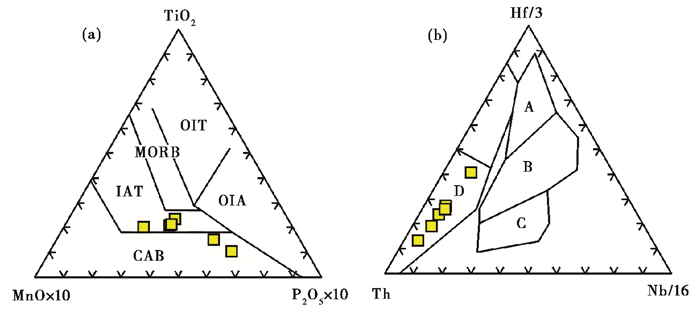
|
图 14 吕梁群近周峪组变质中基性火山岩MnO-TiO2-P2O5 (a, 据Mullen, 1983) 和Th-Hf-Nb (b, 据Wood, 1980) 构造环境判别图 (a) 图中, MORB-大洋中脊玄武岩;OIT-洋岛/海山拉斑玄武岩;OIA-洋岛/海山碱性玄武岩;CAB-岛弧钙碱性玄武岩;IAT-岛弧拉斑玄武岩.(b) 图中, A-正常大洋中脊玄武岩;B-E型大洋中脊玄武岩和板内拉斑玄武岩;C-板内碱性玄武岩;D-火山弧玄武岩 Fig. 14 MnO-TiO2-P2O5 (a, after Mullen, 1983) and Th-Hf-Nb (b, after Wood, 1980) tectonic discrimination diagrams of intermediate basic volcanic rocks in Jinzhouyu Formation of Lüliang Group |
本文获得恶虎滩闪长质片麻岩的SHRIMP锆石U-Pb年龄为2182±5Ma, 代表了该片麻岩的原岩年龄, 与杜家沟长石斑岩及赤坚岭-关帝山杂岩时代相当(耿元生等, 2006;Zhao et al., 2008)。
恶虎滩片麻岩岩性为闪长质-花岗闪长质(SiO2含量54.63%~65.15%), K2O+Na2O含量较高。轻重稀土元素分异较强烈, 且Eu异常较微弱, 表明岩浆源区未发生大量的长石分离结晶或岩石部分熔融属长石的不稳定区域。恶虎滩闪长质片麻岩相对于下地壳SiO2、Al2O3、K2O和Na2O略高, 而低TiO2、FeOT、CaO和MgO (Taylor and McLennan, 1985);微量元素中, 相容性元素Cr、Ni低于下地壳值, 与一些TTG质岩石含量相当(Martin, 1994)。所以, 从主微量元素初步分析, 恶虎滩闪长质片麻岩不可能直接由地幔部分熔融而成, 可能是下地壳岩石部分熔融形成的, 同时有少量地幔物质加入。在花岗质岩石构造环境判别图解中, 恶虎滩片麻岩主要位于火山弧区域和后碰撞花岗岩区域(图 12)。
6.4 2.2~2.1Ga岩浆岩形成环境本文获得杜家沟长石斑岩的锆石U-Pb年龄为~2190Ma, 获得恶虎滩闪长质片麻岩的时代为2182Ma。在吕梁地区, 同期的花岗质侵入体为分布范围较广的赤坚岭-关帝山花岗岩, 其时代为2151~2199Ma (耿元生等, 2000;Zhao et al., 2008)。同时, 吕梁群和野鸡山群中大量出露的变质基性火山岩也可能形成于同一时期(Liu et al., 2012)。以上研究资料表明, 吕梁地区2.2~2.1Ga的岩浆岩活动非常强烈。
近年的研究发现, 在华北克拉通五台(王凯怡和Wilde, 2002;Wilde et al., 2005;Du et al., 2010, 2012)、阜平(Zhao et al., 2002)、恒山(Wang et al., 2010;赵瑞幅等, 2011)、赞皇(杨崇辉等, 2011b;颉颃强等, 2012)、中条(孙大中等, 1991) 和辽吉(Lu et al., 2006) 地区广泛分布2.2~2.0Ga的岩浆岩。这期岩浆活动形成于伸展的构造体制下, 可能与华北克拉通内部2.2~2.0Ga的裂谷活动有关(杜利林等, 2009, 2011;Du et al., 2010, 2012;杨崇辉等, 2011b;赵瑞幅等, 2011;颉颃强等, 2012)。在吕梁地区, 该期岩浆岩的形成环境存在明显不同的认识:刘树文等(2009)、Liu et al.(2012)和Zhao et al.(2008)认为吕梁地区2.2~2.1Ga基性火山岩和花岗岩具有岛弧岩浆特征, 是华北克拉通中部带内西部陆块向东部陆块俯冲过程中岩浆弧的一部分。而耿元生等(2000, 2003) 认为吕梁群近周峪组和野鸡山群白龙山组基性火山岩具有陆内或大陆边缘裂谷型火山岩特征, 其中近周峪组基性火山岩与杜家口组酸性火山岩形成双峰式岩浆组合(于津海等, 1998)。
根据本文研究, 杜家沟长石斑为A2型花岗岩, 具有造山后花岗岩特征, 而吕梁群近周峪组中基性火山岩岛弧火山地球化学特征, 恶虎滩片麻岩具有火山弧或后碰撞岩浆岩特征。有学者提出中部带内可能存在2.2~2.1Ga的碰撞造山事件(Liu et al., 2005;Faure et al., 2007;Trap et al., 2008, 2009;Wang, 2009;Wang et al., 2010), 但该期事件缺少确实的地质证据。根据已有的资料, 本文更倾向于认为, 华北克拉通2.2~2.0Ga的岩浆事件与裂谷有关(杜利林等, 2009, 2011;Du et al., 2010, 2012;杨崇辉等, 2011b;赵瑞幅等, 2011;颉颃强等, 2012)。而吕梁地区同期岩浆岩具有较为复杂的地球化学特征可能与其在早期华北克拉通中所处的位置有关。
Zhai and Santosh (2011)指出, 华北新太古代末初步克拉通化之后, 在2300~2000Ma之间经历陆内裂谷或陆间残留小洋盆的进一步伸展。而Zhao et al.(2008)和Liu et al.(2012)认为古元古代吕梁以西为向东俯冲古大洋。前述的两种模式中, 吕梁地区皆紧邻鄂尔多斯地块。新的研究资料揭示, 鄂尔多斯沉积盖层下的前寒武纪变质表壳岩沉积和变质时代相近(~1.8Ga)(万渝生未发表资料), 与相邻吕梁地区的变质时代相近。所以, 本文初步推断, 在吕梁以西, 可能还存在古元古代的造山带。同时, 目前的研究资料表明, 吕梁地区最老的地质体为盖家庄片麻岩, 其时代为2364~2375Ma (耿元生等, 2006;Zhao et al., 2008), 缺少新太古代的基底岩石(云中山片麻岩与五台地区新太古代片麻岩类似)。因此, 本文认为, 在古元古代吕梁地区可能处于华北古陆块的边缘, 由于洋壳俯冲在大陆边缘形成具有岛弧性质的吕梁群基性火山岩(也可能包括野鸡山群中基性火山岩) 和同期的一些花岗岩。由于华北克拉通在2.2~2.0Ga内部整体处于伸展环境, 杜家沟长石斑岩可能是大陆边缘裂谷环境形成的火山岩, 同时由于陆块边缘洋壳俯冲作用叠加了部分岛弧岩浆的特征。吕梁地区2.2~2.1Ga的岩浆岩可能不同程度受到两种体制的共同影响。
7 结论杜家沟长石斑岩2个样品的SHRIMP锆石U-Pb年龄分别为2189±6Ma和2186±3Ma, 恶虎滩闪长质片麻岩的原岩时代为2182±5Ma。结合区域内~2.2Ga的火山岩和2.2~2.1Ga的花岗岩, 吕梁地区的2.2~2.1Ga的岩浆事件非常强烈。
杜家沟长石斑岩为A2型花岗岩, 具有造山后花岗岩的地球化学特征;而吕梁群近周峪组中基性火山岩具有岛弧火山岩地球化学特征, 恶虎滩片麻岩具有岛弧或后碰撞岩浆特征。吕梁地区2.2~2.1Ga岩浆岩地球化学特征的复杂性可能与其在华北克拉通中的位置有关。华北克拉通2.2~2.0Ga处于陆内裂谷阶段, 而吕梁地区可能处于华北克拉通古陆块的边缘, 其2.2~2.1Ga的岩浆岩可能受岛弧和裂谷两种体制的共同制约。
致谢 在全岩地球化学分析和SHRIMP锆石U-Pb年龄测试过程中, 先后得到国家地质实验测试中心韩慧明老师、北京离子探针中心刘敦一研究员、张玉海高级工程师、杨之青工程师、周慧工程师、董春艳副研究员及中心其他人员和澳大利亚科庭理工大学相关老师的支持和帮助;匿名审稿专家、刘福来研究员和编辑部俞良军博士提出宝贵的修改意见和建议;在此表示衷心感谢!| [] | Amelin Y, Lee DC, Halliday AN. 2000. Early-Middle Archaean crustal evolution deduced from Lu-Hf and U-Pb isotopic studies of single zircon grains. Geochimica et Cosmochimica Acta, 64: 4205–4225. DOI:10.1016/S0016-7037(00)00493-2 |
| [] | Anderson JL. 1983. Proterozoic anorogenic granite plutonism of North America. In: Medaris LG, Mickelson DM, Byers CW and Shanks WC (eds.). Proterozoic Geology. Geol. Soc. Am. Mere., 161: 133–154. |
| [] | Bédard J. 1990. Enclaves from the A-type granite of the Mégantic Complex, White Mountain magma series: Clues to granite magma genesis. J. Geophy. Res., 95: 17797–17819. DOI:10.1029/JB095iB11p17797 |
| [] | Black LP, Kamo SL, Allen CM, Aleinikoff JN, Davis DW, Korsch RJ, Foudoulis C. 2003. TEMORA 1: A new zircon standard for Phanerozoic U-Pb geochronology. Chemical Geology, 200: 155–170. DOI:10.1016/S0009-2541(03)00165-7 |
| [] | Clemens JD, Holloway JR, White AJR. 1986. Origin of an A-type granite: Experimental constraints. American Mineralogist, 71: 317–324. |
| [] | Collins WJ, Beams SD, White AJR, Chappell BW. 1982. Nature and origin of A-type granites with particular reference to Southeastern Australia. Contrib. Mineral. Petrol., 80: 189–200. DOI:10.1007/BF00374895 |
| [] | Creaser RA, Price RC, Wormald RJ. 1991. A-type granites revisited: Assessment of a residual-source model. Geology, 19: 163–166. DOI:10.1130/0091-7613(1991)019<0163:ATGRAO>2.3.CO;2 |
| [] | Du LL, Yang CH, Ren LD, Wan YS, Wu JS. 2009. Petrology, geochemistry and petrogenesis of the metabasalts of the Hutuo Group, Wutai Mountains, Shanxi, China. Geological Bulletin of China, 28(7): 867–876. |
| [] | Du LL, Yang CH, Guo JH, Wang W, Ren LD, Wan YS, Geng YS. 2010. The age of the base of the Paleoproterozoic Hutuo Group in the Wutai Mountains area, North China Craton: SHRIMP zircon U-Pb dating of basaltic andesite. Chinese Science Bulletin, 55: 1782–1789. DOI:10.1007/s11434-009-3611-8 |
| [] | Du LL, Yang CH, Wang W, Ren LD, Wan YS, Song HX, Geng YS, Hou KJ. 2011. The re-exmination of the age and stratigraphic subdivision of the Hutuo Group in the Wutai Mountains area, North China Craton: Evidence from geology and zircon U-Pb geochronology. Acta Petrologica Sinica, 27(4): 1037–1055. |
| [] | Du LL, Yang CH, Wang W, Ren LD, Wan YS, Wu JS, Zhao L, Song HX, Geng YS and Hou KJ. 2012. A 2137Ma SHRIMP U-Pb zircon age for the Huangjinshan A-type granite porphyry in Wutai area and Hf isotopic evidence of its derivation by high temperature melting of Archean crust: Paleoproterozoic rifting of the North China Craton. Journal of Asian Earth Sciences, under review |
| [] | Eby GN. 1990. The A-type granitoids: A review of their occurrence and chemical characteristics and speculations on their petrogenesis. Lithos, 26: 115–134. DOI:10.1016/0024-4937(90)90043-Z |
| [] | Eby GN. 1992. Chemical subdivision of the A-type granitoids: Petrogenetic and tectonic implications. Geology, 20: 641–644. DOI:10.1130/0091-7613(1992)020<0641:CSOTAT>2.3.CO;2 |
| [] | Faure M, Trap P, Lin W, Monié P, Bruguier O. 2007. Polyorogenic evolution of the Paleoproterozoic Trans-North China Belt-New insights from the Lüliangshan-Hengshan-Wutaishan and Fuping massifs. Episodes, 30: 96–107. |
| [] | Geng YS, Wan YS, Shen QH, Li HM, Zhang RX. 2000. Chronological framework of the Early Precambrian important events in the Lüliang area, Shanxi Province. Acta Geologica Sinica, 74(3): 216–223. |
| [] | Geng YS, Wan YS, Yang CH. 2003. The Paleoproterozoic rift-type volcanism in Lüliangshan area, Shanxi Province, and its geological significance. Acta Geoscientia Sinica, 24(2): 97–104. |
| [] | Geng YS, Yang CH, Wan YS. 2006. Paleoproterozoic granitic magmatism in the Lüliang area, North China Craton: Constraint from isotopic geochronology. Acta Petrologica Sinica, 22(2): 305–314. |
| [] | Geng YS, Wan YS, Yang CH. 2008. Integrated research report on the establishment of Paleoproterozoic system of China: Determination of major Paleoproterozoic geological events and prelimary subdivision of Paleoproterozoic strata in the Lüliang area. Research Report on the Establishment of Major Stratigraphical Stages in China (2001-2005).. Beijing: Geological Publishing House: 515-533. |
| [] | Guan H, Sun M, Wilde SA, Zhou XH, Zhai MG. 2002. SHRIMP U-Pb zircon geochronology of the Fuping Complex: Implications for formation and assembly of the North China Craton. Precambrian Research, 113: 1–18. DOI:10.1016/S0301-9268(01)00197-8 |
| [] | Guo JH, O'Brien PJ, Zhai M. 2002. High-pressure granulites in the Sanggan area, North China craton: Metamorphic evolution, P-T paths and geotectonic significance. Journal of Metamorphic Geology, 20: 741–756. DOI:10.1046/j.1525-1314.2002.00401.x |
| [] | Guo JH, Sun M, Chen FK, Zhai MG. 2005. Sm-Nd and SHRIMP U-Pb zircon geochronology of high-pressure granulites in the Sanggan area, North China Craton: Timing of Paleoproterozoic continental collision. Journal of Asian Earth Sciences, 24: 629–642. DOI:10.1016/j.jseaes.2004.01.017 |
| [] | Henderson P. 1984. General geochemical properties and abundances of the rare earth elements. In: Henderson P (ed.). Rare Earth Element Geochemistry. New York: Elsevier, 1-32 |
| [] | Hong DW, Wang SG, Han BF, Jin MY. 1996. Post-orogenic alkaline granites from China and comparisions with anorogenic alkaline granites elsewhere. Journal of Southeast Asian Earth Sciences, 13: 13–27. DOI:10.1016/0743-9547(96)00002-5 |
| [] | Jiang N, Zhang SQ, Zhou WG, Liu YS. 2009. Origin of a Mesozoic granite with A-type characterisitics from the North China craton: Highly fractionated from Ⅰ-type magma? Contrib. Mineral. Petrol., 158: 113–130. DOI:10.1007/s00410-008-0373-2 |
| [] | Kerr A, Fryer BJ. 1993. Nd isotopic evidence for crust-mantle interaction in the generation of A-type granitoid suites in Labrador, Canada. Chem. Geol., 104: 39–60. DOI:10.1016/0009-2541(93)90141-5 |
| [] | King PL, White AJR, Chappell BW, Allen CM. 1997. Characterization and origin of aluminous A-type granites from the Lachlan Fold Belt, Southeastern Australia. Journal of Petrology, 38: 371–391. DOI:10.1093/petroj/38.3.371 |
| [] | Kröner A, Wilde SA, Li JH, Wang KY. 2005a. Age and evolution of a Late Archean to Paleoproterozoic upper to lower crustal section in the Wutaishan/Hengshan/Fuping terrain of northern China. Journal of Asian Earth Sciences, 24: 577–595. DOI:10.1016/j.jseaes.2004.01.001 |
| [] | Kröner A, Wilde SA, O'Brien PJ, Li JH, Passchier CW, Walte NP, Liu DY. 2005b. Field relationships, geochemistry, zircon ages and evolution of a Late Archaean to Palaeoproterozoic lower crustal section in the Hengshan terrain of northern China. Acta Geologica Sinica, 79(5): 605–629. |
| [] | Kröner A, Wilde SA, Zhao GC, O'Brien PJ, Sun M, Liu DY, Wan YS, Liu SW, Guo JH. 2006. Zircon geochronology and metamorphic evolution of mafic dykes in the Hengshan Complex of northern China: Evidence for Late Paleoproterozoic extension and subsequent high-pressure metamorphism in the North China Craton. Precambrian Research, 146: 45–67. DOI:10.1016/j.precamres.2006.01.008 |
| [] | Kusky TM, Li JH. 2003. Paleoproterozoic tectonic evolution of the North China Craton. Journal of Asian Earth Sciences, 22: 383–397. DOI:10.1016/S1367-9120(03)00071-3 |
| [] | Kusky TM, Li JH, Santosh M. 2007. The Paleoproterozoic North Hebei Orogen: North China Craton's collisional suture with the Columbia supercontinent. Gondwana Research, 12: 4–28. DOI:10.1016/j.gr.2006.11.012 |
| [] | Li JH, Kusky TM. 2007. A Late Archean foreland fold and thrust belt in the North China Craton: Implications for early collisional tectonics. Gondwana Research, 12: 47–66. DOI:10.1016/j.gr.2006.10.020 |
| [] | Litvinovsky BA, Jahn BM, Zanvilevich AN, Saunders A, Poulain S, Kuzmin DV, Reichow MK, Titov AV. 2002. Petrogenesis of syenite-granite suites from the Bryansky Complex (Transbaikalia, Russia): Implications for the origin of A-type granitoid magmas. Chem. Geol., 189: 105–133. DOI:10.1016/S0009-2541(02)00142-0 |
| [] | Liu CH, Zhao GC, Sun M, Wu FY, Yang JH, Yin CQ, Leung WH. 2011. U-Pb and Hf isotopic study of detrital zircons from the Yejishan Group of the Lüliang Complex: Constraints on the timing of collision between the Eastern and Western blocks, North China Craton. Sedimentary Geology, 236: 129–140. DOI:10.1016/j.sedgeo.2011.01.001 |
| [] | Liu JZ, Zhang FQ, Ouyang ZY, Li CL, Zou YL, Xu L. 2003. Geochemistry and chronology of the Jiehekou Group metamorphic basic volcanic rocks in the Lüliang Mountain area, Shanxi, China. Science in China (Series D), 46(11): 1171–1181. DOI:10.1360/99yd0278 |
| [] | Liu SW, Pan YM, Xie QL, Zhang J, Li QG. 2004. Archean geodynamics in the Central Zone, North China Craton: Constraints from geochemistry of two contrasting series of granitoids in the Fuping and Wutai complexes. Precambrian Research, 130: 229–249. DOI:10.1016/j.precamres.2003.12.001 |
| [] | Liu SW, Pan YM, Xie QL, Zhang J, Li QG, Yang B. 2005. Geochemistry of the Paleoproterozoic Nanying granitic gneisses in the Fuping Complex: Implications for the tectonic evolution of the Central Zone, North China Craton. Journal of Asian Earth Sciences, 24: 643–658. DOI:10.1016/j.jseaes.2003.10.010 |
| [] | Liu SW, Zhao GC, Wilde SA, Shu GM, Sun M, Li QG, Tian W, Zhang J. 2006. Th-U-Pb monazite geochronology of the Lüliang and Wutai Complexes: Constraints on the tectonothermal evolution of the Trans-North China Orogen. Precambrian Research, 148: 205–224. DOI:10.1016/j.precamres.2006.04.003 |
| [] | Liu SW, Li QG, Zhang LF. 2009. Geology, geochemistry of metamorphic volcanic rock suite in Precambrian Yejishan Group, Lüliang Mountains and its tectonic implications. Acta Petrologica Sinica, 25(3): 547–560. |
| [] | Liu SW, Zhang J, Li QG, Zhang LF, Wang W and Yang PT. 2012. Geochemistry and U-Pb zircon ages of metamorphic volcanic rocks of the Paleoproterozoic Lüliang Complex and constraints on the evolution of the Trans-North China Orogen, North China Craton. Precambrian Research, in press |
| [] | Loiselle MC, Wones DR. 1979. Characteristics and origin of anorogenic granites. Geological Society of America Abstracts with Programs, 11: 468. |
| [] | Lu XP, Wu FY, Guo JH, Wilde SA, Yang JH, Liu XM, Zhang XO. 2006. Zircon U-Pb geochronological constraints on the Paleoproterozoic crustal evolution of the Eastern block in the North China Craton. Precambrian Research, 146: 138–164. DOI:10.1016/j.precamres.2006.01.009 |
| [] | Ludwig KR. 2000. User's manual for Isoplot/Ex version 2.2: A geochronological toolkit for Microsoft Excel. Berkeley Geochronology Center Special Publication, No. 1a: 1-50 |
| [] | Ludwig KR. 2001. Squid 1.02: A User's Manual. Berkeley Geochronology Center Special Publication, No. 2: 1-19 |
| [] | Maniar PD, Piccoli PM. 1989. Tectonic discrimination of granitoids. Geological Society of American Bulletin, 101: 635–643. DOI:10.1130/0016-7606(1989)101<0635:TDOG>2.3.CO;2 |
| [] | Martin H. 1994. The Archean grey gneisses and the genesis of the continental crust. In: Condie KC (ed.). The Archean Crustal Evolution. Elsevier, 205-259 |
| [] | Miller CF, McDowell SM, Mapes RW. 2003. Hot and cold granites?. Implication of zircon saturation temperatures and preservation of inheritance. Geology, 31: 529–532. |
| [] | Mingram B, Trumbull RB, Littman S, Gerstenberger H. 2000. A petrogenetic study of anorogenic felsic magmatism in the Cretaceous Paresis ring complex, Namibia: Evidence for mixing of crust and mantle-derived components. Lithos, 54: 1–22. DOI:10.1016/S0024-4937(00)00033-5 |
| [] | Miyashiro A. 1974. Volcanic rock series in island areas and active continental margins. American Journal of Sciences, 274: 324–355. |
| [] | Mullen ED. 1983. MnO/TiO2/P2O5: A minor element discriminant for basaltic rocks of oceanic environments and its implications for petrogenesis. Earth and Planetary Science Letters, 62: 53–62. DOI:10.1016/0012-821X(83)90070-5 |
| [] | Mushkin A, Navon O, Halicz L, Hartmann G, Stein M. 2003. The petrogenesis of A-type magmas from the Amram Massif, southern Israel. J. Petrol., 44: 815–832. DOI:10.1093/petrology/44.5.815 |
| [] | Patiño Dounce AE. 1997. Generation of metaluminous A-type granites by low-pressure melting of calc-alkaline granitoids. Geology, 25: 743–746. DOI:10.1130/0091-7613(1997)025<0743:GOMATG>2.3.CO;2 |
| [] | Pearce JA, Harris NBW, Tindle AG. 1984. Trace element discrimination diagrams for the tectonic interpretation of granitic rocks. Journal of Petrology, 25: 956–983. DOI:10.1093/petrology/25.4.956 |
| [] | Polat A, Kusky T, Li JH, Fryer B, Kerrich R, Patrick K. 2005. Geochemistry of Neoarchean (ca. 2.55~2.50Ga) volcanic and ophiolitic rocks in the Wutaishan greenstone belt, central orogenic belt, North China Craton: Implications for geodynamic setting and continental growth. GSA Bulletin, 117: 1387–1399. DOI:10.1130/B25724.1 |
| [] | Shen QH, Qian XL. 1995. Assemblages, episodes and tectonic evolution in the Archaean of China. Episodes, 18: 44–48. |
| [] | Shen QH. 2009. The recommendation of a systematic list of mineral abbreviations. Acta Petrologica et Mineralogica, 28(5): 495–500. |
| [] | Skjerlie KP, Johnston AD. 1993. Vapor-absent melting at 10kbar of a biotite-and amphibole-bearing tonalitic gneiss: implications for the generation of A-type granites. Geology, 20: 263–266. |
| [] | Song B, Zhang YH, Wan YS, Jian P. 2002. Mount making and procedure of the SHRIMP dating. Geol. Rev., 48(Suppl.): 26–30. |
| [] | Sun DZ, Li HM, Lin YX, Zhou HF, Zhao FQ, Tang M. 1991. Precambrian geochronology, chronotectonic framework and model of chronocrustal structure of the Zhongtiao Mountains. Acta Geologica Sinica(3): 216–231. |
| [] | Sun SS, McDonough WF. 1989. Chemical and isotopic systematics of oceanic basalts: Implications for mantle composition and processes. In: Saunders AD and Norry MJ (eds.). Magmatism in the Oecan Basins. The Geological Society of Special Publication, 42: 313–345. DOI:10.1144/GSL.SP.1989.042.01.19 |
| [] | Taylor SR and McLennan SM. 1985. The Continental Crust: Its Composition and Evolution. An Examination of the Geochemical Record Preserved in Sedimentary Rocks. Blackwell Scientific Publications, 1-312 |
| [] | Trap P, Faure M, Lin W, Bruguier O, Monié P. 2008. Contrasted tectonic styles for the Paleoproterozoic evolution of the North China Craton. Evidence for a~2.1Ga thermal and tectonic event in the Fuping Massif. Journal of Structural Geology, 30: 1109–1125. DOI:10.1016/j.jsg.2008.05.001 |
| [] | Trap P, Faure M, Lin W, Monié P, Meffre S, Melleton J. 2009. The Zanhuang Massif, the second and eastern suture zone of the Paleoproterozoic Trans-North China Orogen. Precambrian Research, 172: 80–98. DOI:10.1016/j.precamres.2009.03.011 |
| [] | Turner SP, Foden JD, Morrison RS. 1992. Derivation of some A-type magmas by fractionation of basaltic magma: An example from the Padthaway Ridge, South Australia. Lithos, 28: 151–179. DOI:10.1016/0024-4937(92)90029-X |
| [] | Wan YS, Geng YS, Shen QH, Zhang RX. 2000. Khondalite series: Geochronology and geochemistry of the Jiehekou Group in Lüliang area, Shanxi Province. Acta Petrologica Sinica, 16(1): 49–58. |
| [] | Wan YS, Wilde SA, Liu DY, Yang CX, Song B, Yin XY. 2006a. Further evidence for 1.85Ga metamorphism in the Central Zone of the North China Craton: SHRIMP U-Pb dating of zircon from metamorphic rocks in the Lushan area, Henan Province. Gondwana Research, 9: 189–197. DOI:10.1016/j.gr.2005.06.010 |
| [] | Wan YS, Song B, Liu DY, Wilde SA, Wu JS, Shi YR, Yin XY, Zhou HY. 2006b. SHRIMP U-Pb zircon geochronology of Paleoproterozoic metasedimentary rocks in the North China Craton: Evidence for a major Late Paleoproterozoic tectonothermal event. Precambrian Research, 149: 249–271. DOI:10.1016/j.precamres.2006.06.006 |
| [] | Wang KY, Wilde S. 2002. Precise SHRIMP U-Pb ages of Dawaliang granite in Wutaishan area, Shanxi. Acta Petrologica et Mineralogica, 21: 407–411. |
| [] | Wang ZH. 2009. Tectonic evolution of the Hengshan-Wutai-Fuping complexes and its implication for the Trans-North China Orogen. Precambrian Research, 170: 73–87. DOI:10.1016/j.precamres.2008.11.003 |
| [] | Wang ZH, Wilde SA, Wan JL. 2010. Tectonic setting and significance of 2.3~2.1Ga magmatic events in the Trans-North China Orogen: New constraints from the Yanmenguan mafic-ultramafic intrusion in the Hengshan-Wutai-Fuping area. Precambrian Research, 178: 27–42. DOI:10.1016/j.precamres.2010.01.005 |
| [] | Watson EB, Harrison TM. 1983. Zircon saturation revisited: Temperature and composition effects in a variety of crustal magma types. Earth and Planetary Science Letters, 64: 295–304. DOI:10.1016/0012-821X(83)90211-X |
| [] | Whalen JB, Currie KL, Chappell BW. 1987. A-type granites: Geochemical characteristics, discrimination and petrogenesis. Contrib. Mineral. Petrol., 95: 407–419. DOI:10.1007/BF00402202 |
| [] | White AJR, Chappell BW. 1983. Granitoid types and their distribution in the Lachlan Fold Belt, Southeastern Australia. Geological Society of America Memoir, 159: 117–148. |
| [] | Wilde SA, Cawood PA, Wang KY, Nemchim AA. 2005. Granitoid evolution in the Late Archean Wutai Complex, North China Craton. Journal of Asian Earth Sciences, 24: 597–613. DOI:10.1016/j.jseaes.2003.11.006 |
| [] | Williams IS. 1998. U-Th-Pb geochronology by ion microprobe. In: Mickibben MA, Shanks Ⅲ WC and Ridley WI (eds.). Applications of Micro Analytical Techniques to Understanding Mineralizing Process.. Rev. Economic Geol., 7: 1–35. DOI:10.1080/07474938808800138 |
| [] | Wilson M. 1989. Igneous Petrogenesis. Springer, 1-466 |
| [] | Winchester JA, Floyd PA. 1977. Geochemical discrimination of different magma series and their differentiation products using immobile elements. Chemical Geology, 20: 325–343. DOI:10.1016/0009-2541(77)90057-2 |
| [] | Wood DA. 1980. The application of a Th-Hf-Ta diagram to problems of tectonomagmatic classification and to establishing the nature of crustal contamination of basaltic lavas of the British Tertiary volcanic province. Earth and Planetary Science Letters, 50: 11–30. DOI:10.1016/0012-821X(80)90116-8 |
| [] | Wu JS, Geng YS, Shen QH, Wan YS, Liu DY, Song B. 1998. Archaean Geology Characteristics and Tectonic Evolution of China-Korea Paleo-continent. Beijing: Geological Publishing House: 1-212. |
| [] | Xie HQ, Liu DY, Yin XY, Zhou HY, Yang CH, Du LL and Wan YS. 2012. Age and tectonic setting of Gantaohe Group: Geology, geochemistry and zircon SHRIMP U-Pb dating. Chinese Science Bulletin, in press |
| [] | Yang CH, Du LL, Ren LD, Song HX, Wan YS, Xie HQ, Liu ZX. 2011a. Petrogenesis and geodynamics setting of Jiandeng potassic granite at the end of the Neoarchean in Zanhuang Complex, North China Craton. Earth Science Frontiers, 18(2): 62–78. |
| [] | Yang CH, Du LL, Ren LD, Song HX, Wan YS, Xie HQ, Liu ZX. 2011b. The age and petrogenesis of the Xuting granite in the Zanhuang Complex, Hebei Province: Constraints on the structural evolution of the Trans-North China Orogen, North China Craton. Acta Petrologica Sinica, 27(4): 1003–1016. |
| [] | Yang JH, Wu FY, Chung SL, Wilde SA, Chu MF. 2006. A hybrid origin for the Qianshan A-type granite, Northeast China: Geochemical and Sr-Nd-Hf isotopic evidence. Lithos, 89: 89–106. DOI:10.1016/j.lithos.2005.10.002 |
| [] | Yu JH, Wang DZ, Wang CY, Li HM. 1997. Ages of the Lüliang Group and its main metamorphism in the Lüliang Mountains, Shanxi: Evidence from single-grain zircon U-Pb ages. Geological Review, 43(4): 403–408. |
| [] | Yu JH, Wang DZ, Geng JH. 1998. A Paleoproterozoic A-type rhyolite. Geochimica, 27(6): 549–558. |
| [] | Zhai MG, Bian AG, Zhao TP. 2000. Amalgamation of the supercontinental of the North China craton and its break up during Late-Middle Proterozoic. Science in China (Series D), 43: 219–232. DOI:10.1007/BF02911947 |
| [] | Zhai MG, Guo JH, Liu WJ. 2005. Neoarchean to Paleoproterozoic continental evolution and tectonic history of the North China Craton: A review. Journal of Asian Earth Sciences, 24: 547–561. DOI:10.1016/j.jseaes.2004.01.018 |
| [] | Zhai MG. 2011. Cratonization and the Ancient North China Continent: A summary and review. Science China Earth Science, 54(8): 1110–1120. DOI:10.1007/s11430-011-4250-x |
| [] | Zhai MG, Santosh M. 2011. The Early Precambrian odyssey of the North China Craton: A synoptic overview. Gondwana Research, 20: 6–25. DOI:10.1016/j.gr.2011.02.005 |
| [] | Zhang J, Zhao GC, Li SZ, Sun M, Liu SW, Wilde SA, Kröner A, Yin CQ. 2007. Deformation history of the Hengshan Complex: Implications for the tectonic evolution of the Trans-North China Orogen. Journal of Structural Geology, 29: 933–949. DOI:10.1016/j.jsg.2007.02.013 |
| [] | Zhang J, Zhao GC, Li SZ, Sun M, Wilde SA, Liu SW, Yin CQ. 2009. Polyphase deformation of the Fuping Complex, Trans-North China Orogen: Structures, SHRIMP U-Pb zircon ages and tectonic implications. Journal of Structural Geology, 31: 177–193. DOI:10.1016/j.jsg.2008.11.008 |
| [] | Zhang Q, Wang Y, Li CD, Wang YL, Jin WJ, Jia XQ. 2006. Granite classification on the basis of Sr and Yb contents and its implications. Acta Petrologica Sinica, 22(9): 2249–2269. |
| [] | Zhang ZQ, Xue WY, Wei YF, Chai JZ. 2004. A new attempt to map the northern segment of the Lüliang Mountains, Shanxi, using the slab method. Geology in China, 31(2): 155–160. |
| [] | Zhao GC, Wilde SA, Cawood PA, Lu LZ. 1999a. Tectonothermal history of the basement rocks in the western zone of the North China Craton and its tectonic implications. Tectonophysics, 310: 37–53. DOI:10.1016/S0040-1951(99)00152-3 |
| [] | Zhao GC, Cawood P, Lu LZ. 1999b. Petrology and P-T history of the Wutai amphibolites: Implications for tectonic evolution of the Wutai Complex, China. Precambrian Research, 93: 181–199. DOI:10.1016/S0301-9268(98)00090-4 |
| [] | Zhao GC, Cawood PA, Wilde SA, Sun M, Lu LZ. 2000. Metamorphism of basement rocks in the Central Zone of the North China Craton: Implications for Paleoproterozoic tectonic evolution. Precambrian Research, 103: 55–88. DOI:10.1016/S0301-9268(00)00076-0 |
| [] | Zhao GC, Wilde SA, Cawood P, Sun M. 2002. SHRIMP U-Pb zircon ages of the Fuping complex: Implications for Late Archean to Paleoproterozoic accretion and assembly of the North China Craton. American Journal of Science, 302: 191–226. DOI:10.2475/ajs.302.3.191 |
| [] | Zhao GC, Sun M, Wilde SA, Li SZ. 2005. Late Archean to Paleoproterozoic evolution of the North China Craton: Key issues revisited. Precambrian Research, 136: 177–202. DOI:10.1016/j.precamres.2004.10.002 |
| [] | Zhao GC, Wilde SA, Sun M, Li SZ, Li XP, Zhang J. 2008. SHRIMP U-Pb zircon ages of granitoid rocks in the Lüliang Complex: Implications for the accretion and evolution of the Trans-North China Orogen. Precambrian Research, 160: 213–226. DOI:10.1016/j.precamres.2007.07.004 |
| [] | Zhao GC, Wilde SA, Guo JH, Cawood PA, Sun M, Li XP. 2010. Single zircon grains record two Paleoproterozoic collisional events in the North China Craton. Precambrian Research, 177: 266–276. DOI:10.1016/j.precamres.2009.12.007 |
| [] | Zhao RF, Guo JH, Peng P, Liu F. 2011. Crustal remelting event in Hengshan Complex: Evidence from zircon U-Pb dating and Hf-Nd isotopic study on potassic granites. Acta Petrologica Sinica, 27(6): 1607–1623. |
| [] | Zhou YY, Zhao TP, Wang CY, Hu GH. 2011. Geochronology and geochemistry of 2.5 to 2.4Ga granitic plutons from the southern margin of the North China Craton: Implications for a tectonic transition from arc to post-collisional setting. Gondwana Research, 20: 171–183. DOI:10.1016/j.gr.2011.03.004 |
| [] | 杜利林, 杨崇辉, 任留东, 万渝生, 伍家善. 2009. 山西五台山区滹沱群变质玄武岩岩石学、地球化学特征及其成因意义. 地质通报, 28(7): 867–876. |
| [] | 杜利林, 杨崇辉, 王伟, 任留东, 万渝生, 宋会侠, 耿元生, 侯可军. 2011. 五台地区滹沱群时代与地层划分新认识:地质学与锆石年代学证据. 岩石学报, 27(4): 1037–1055. |
| [] | 耿元生, 万渝生, 沈其韩, 李惠民, 张如心. 2000. 吕梁地区早前寒武纪主要地质事件的年代格架. 地质学报, 74(3): 216–223. |
| [] | 耿元生, 万渝生, 杨崇辉. 2003. 吕梁地区古元古代的裂陷型火山作用及其地质意义. 地球学报, 24(2): 97–104. |
| [] | 耿元生, 杨崇辉, 万渝生. 2006. 吕梁地区古元古代花岗岩浆作用——来自同位素年代学的证据. 岩石学报, 22(2): 305–314. |
| [] | 耿元生, 万渝生, 杨崇辉. 2008. 中国古元古界建系综合研究报告——吕梁地区古元古代主要地质事件的厘定和古元古代的初步划分.中国主要断代地层建阶研究报告(2001~2005). 北京: 地质出版社: 515-533. |
| [] | 刘树文, 李秋根, 张立飞. 2009. 吕梁山前寒武纪野鸡山群火山岩的地质学、地球化学及其构造意义. 岩石学报, 25(3): 547–560. |
| [] | 宋彪, 张玉海, 万渝生, 简平. 2002. 锆石SHRIMP样品靶制作、年龄测定及有关现象讨论. 地质论评, 48(增刊): 26–30. |
| [] | 沈其韩. 2009. 推荐一个系统的矿物缩写表. 岩石矿物学杂志, 28(5): 495–500. |
| [] | 孙大中, 李惠民, 林源贤, 周慧芳, 赵凤清, 唐敏. 1991. 中条山前寒武纪年代学、年代构造格架和年代地壳结构模式的研究. 地质学报(3): 216–231. |
| [] | 万渝生, 耿元生, 沈其韩, 张如心. 2000. 孔兹岩系——山西吕梁地区界河口群的年代学和地球化学. 岩石学报, 16(1): 49–58. |
| [] | 王凯怡, WildeS. 2002. 山西五台地区大洼梁花岗岩的SHRIMP锆石U-Pb精确年龄. 岩石矿物学杂志, 21: 407–411. |
| [] | 伍家善, 耿元生, 沈其韩, 万渝生, 刘敦一, 宋彪. 1998. 中朝古大陆太古宙地质特征及构造演化. 北京: 地质出版社: 1-212. |
| [] | 颉颃强, 刘敦一, 殷小艳, 周红英, 杨崇辉, 杜利林, 万渝生. 2012.甘陶河群形成时代和构造环境:地质、地球化学和锆石SHRIMP定年.科学通报, 出版中 http://cn.bing.com/academic/profile?id=0853c30e40b939711eb5caafb4fde953&encoded=0&v=paper_preview&mkt=zh-cn |
| [] | 杨崇辉, 杜利林, 任留东, 宋会侠, 万渝生, 颉颃强, 刘増校. 2011a. 赞皇杂岩中太古宙末期菅等钾质花岗岩的成因及动力学背景. 地学前缘, 18(2): 62–78. |
| [] | 杨崇辉, 杜利林, 任留东, 宋会侠, 万渝生, 颉颃强, 刘増校. 2011b. 河北赞皇地区许亭花岗岩的时代及成因:对华北克拉通中部构造带演化的制约. 岩石学报, 27(4): 1003–1016. |
| [] | 于津海, 王德滋, 王赐银, 李惠民. 1997. 山西吕梁群和其主变质作用的锆石U-Pb年龄. 地质论评, 43(4): 403–408. |
| [] | 于津海, 王德滋, 耿建华. 1998. 一个古元古代A型流纹岩. 地球化学, 27(6): 549–558. |
| [] | 张旗, 王焰, 李承东, 王元龙, 金惟俊, 贾秀勤. 2006. 花岗岩的Sr-Yb分类及其地质意义. 岩石学报, 22(9): 2249–2269. |
| [] | 张兆琪, 薛文彦, 魏云峰, 柴金钟. 2004. 山西吕梁山北段岩片法填图新尝试. 中国地质, 31(2): 155–160. |
| [] | 赵瑞幅, 郭敬辉, 彭澎, 刘富. 2011. 恒山地区古元古代2.1Ga地壳重熔事件:钾质花岗岩锆石U-Pb定年及Hf-Nd同位素研究. 岩石学报, 27(6): 1607–1623. |
 2012, Vol. 28
2012, Vol. 28

